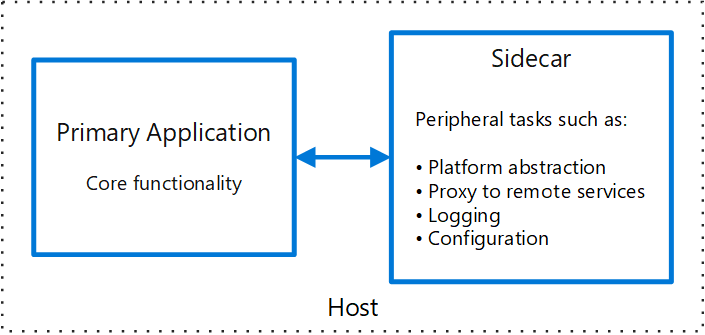The Sidecar Pattern: A Comprehensive Guide to Enhancing Microservices
Introduction
In the world of microservices, the Sidecar Pattern has emerged as a powerful design pattern that promotes modularity, scalability, and maintainability. This blog post delves into the intricate details of the Sidecar Pattern, its underlying principles, benefits, use cases, and practical implementation.
Introduction to the Sidecar Pattern
The Sidecar Pattern is a structural design pattern where a sidecar container is deployed alongside the main application container. Unlike traditional monolithic architectures, this pattern allows developers to extend or add functionalities to a service without modifying its code.
Main Components
-
Main Container: The core application that performs the primary business logic.
-
Sidecar Container: A supplementary container that runs alongside the main container, providing additional functionalities.
 Image credits to microsoft
Image credits to microsoft
Why Use the Sidecar Pattern?
1. Modularity
-
Separation of Concerns: By isolating different functionalities, the Sidecar Pattern ensures that each component focuses on a specific task.
-
Cleaner Code: It helps in keeping the main application codebase clean and focused on core business logic.
2. Reusability
-
Consistent Implementation: Sidecars can be reused across different services, ensuring consistency in features like logging, monitoring, etc.
-
Reduced Duplication: By reusing sidecars, developers can minimize code duplication and maintain a uniform approach across services.
3. Scalability
-
Independent Scaling: Sidecars can be scaled independently of the main application, allowing for more granular control over resources.
-
Adaptability: It enables the system to adapt to varying loads by scaling specific functionalities as needed.
4. Ease of Maintenance
-
Isolated Updates: Sidecars allow for updating or modifying specific features without affecting the main application.
-
Enhanced Testability: By isolating functionalities, testing becomes more straightforward and focused.
Common Use Cases
1. Logging and Monitoring
-
Real-time Insights: Sidecars can collect logs and metrics, providing real-time insights into application performance.
-
Centralized Management: By using a common logging sidecar, logs can be managed centrally, making analysis and troubleshooting easier.
2. Security
-
Authentication and Authorization: Sidecars can handle security protocols, ensuring that only authorized users access the services.
-
Encryption: They can manage encryption and decryption, securing data in transit.
3. Networking
-
Load Balancing: Sidecars can manage the distribution of network traffic, ensuring optimal resource utilization.
-
Service Discovery: They can facilitate service discovery, enabling seamless communication between microservices.
4. Data Transformation
-
Format Transformation: Sidecars can transform data formats between the main application and external services, ensuring compatibility.
-
Data Enrichment: They can enrich data by adding additional information or performing computations.
Implementing the Sidecar Pattern
Technologies
-
Docker: Containers can be defined using Docker, allowing the main application and sidecar to run in separate containers but share the same network space.
-
Kubernetes: Kubernetes provides native support for deploying sidecars, offering more control and automation.
Example with Kubernetes
Here's an example of deploying a logging sidecar with a main application in Kubernetes:
apiVersion: v1
kind: Pod
metadata:
name: my-app
spec:
containers:
- name: main-container
image: main-app:latest
- name: logging-sidecar
image: logger:latest
Conclusion
The Sidecar Pattern is more than just a design pattern; it's a philosophy that encourages modular, scalable, and maintainable microservices architecture. By understanding its principles and leveraging its benefits, developers and architects can build robust and adaptable systems that stand the test of time.
Whether you're building a new microservices-based system or enhancing an existing one, the Sidecar Pattern offers a versatile and efficient way to add functionalities and manage complexities.
